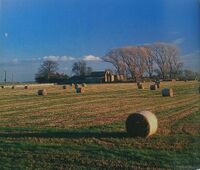Lincolnshire
| Author:Laxman Burdak, IFS (R) |

Lincolnshire (लिंकनशायर) is a county in the East Midlands of England, with a long coastline on the North Sea to the east. The county town is the city of Lincoln, where the county council is based.
Location
It borders Norfolk to the south-east, Cambridgeshire to the south, Rutland to the south-west, Leicestershire and Nottinghamshire to the west, South Yorkshire to the north-west, and the East Riding of Yorkshire to the north. It also borders Northamptonshire in the south for just 19 m, England's shortest county boundary.[1]
History
During pre-Roman times, most of Lincolnshire was inhabited by the Corieltauvi people. The language of the area at that time would have been Common Brittonic, the precursor to modern Welsh. The name Lincoln was derived from Lindum Colonia.
Large numbers of Germanic speakers from continental Europe settled in the region following the withdrawal of the Romans. Though these were later identified as Angles, it is unlikely that they migrated as part of an organized tribal group.[2] Thus, the main language of the region quickly became Old English. However, it is possible that Brittonic continued to be spoken in some communities as late as the eighth century.[3]
Modern-day Lincolnshire is derived from the merging of the territory of the Kingdom of Lindsey with that controlled by the Danelaw borough of Stamford. For some time the entire county was called "Lindsey", and it is recorded as such in the 11th-century Domesday Book. Later, the name Lindsey was applied to the northern core, around Lincoln. This emerged as one of the three Parts of Lincolnshire, along with the Parts of Holland in the south-east, and the Parts of Kesteven in the south-west, which each had separate Quarter Sessions as their county administrations.
In 1888 when county councils were set up, Lindsey, Holland and Kesteven each received separate ones. These survived until 1974, when Holland, Kesteven, and most of Lindsey were unified into Lincolnshire. The northern part of Lindsey, including Scunthorpe Municipal Borough and Grimsby County Borough, was incorporated into the newly formed non-metropolitan county of Humberside, along with most of the East Riding of Yorkshire. County and County Borough areas pre 1965
A local government reform in 1996 abolished Humberside. The land south of the Humber Estuary was allocated to the unitary authorities of North Lincolnshire and North East Lincolnshire. These two areas became part of Lincolnshire for ceremonial purposes, such as the Lord-Lieutenancy, but are not covered by the Lincolnshire police; they are in the Yorkshire and the Humber region.
The remaining districts of Lincolnshire are Boston, East Lindsey, Lincoln, North Kesteven, South Holland, South Kesteven, and West Lindsey. They are part of the East Midlands region.
Lincolnshire is home to Woolsthorpe Manor, birthplace and home of Sir Isaac Newton. He attended The King's School, Grantham. Its library has preserved his signature, carved into a window sill when he was a youth.
Geography
The ceremonial county of Lincolnshire consists of the non-metropolitan county of Lincolnshire and the area covered by the unitary authorities of North Lincolnshire and North East Lincolnshire. Part of the ceremonial county is in the Yorkshire and the Humber region of England, and most is in the East Midlands region. The county is the second-largest of the English ceremonial counties and one that is predominantly agricultural in land use. The county is fourth-largest of the two-tier counties, as the unitary authorities of North Lincolnshire and North East Lincolnshire are not included.
The county has several geographical sub-regions, including the rolling chalk hills of the Lincolnshire Wolds, the Lincolnshire Fens (south-east Lincolnshire), the Carrs (similar to the Fens but in north Lincolnshire), the industrial Humber Estuary and North Sea coast around Grimsby and Scunthorpe, and in the south-west of the county, the Kesteven Uplands, rolling limestone hills in the district of South Kesteven.
The biggest rivers in Lincolnshire are the Trent, running northwards from Staffordshire up the western edge of the county to the Humber estuary, and the Witham, which begins in Lincolnshire at South Witham and runs for 132 km through the middle of the county, eventually emptying into the North Sea at The Wash. The Humber estuary, on Lincolnshire's northern border, is also fed by the River Ouse. The Wash is also the mouth of the Welland, the Nene and the Great Ouse.
Lincolnshire's geography is fairly varied, but consists of several distinct areas:
Lincolnshire Wolds: area of rolling hills in the north-east of the county designated an Area of Outstanding Natural Beauty
The Fens: dominating the south-east quarter of the county
The Marshes: running along the coast of the county
Lincoln Edge or Cliff: limestone escarpment running north–south along the western half of the county
Lincolnshire's most well-known nature reserves include Gibraltar Point National Nature Reserve, Whisby Nature Park Local Nature Reserve, Donna Nook National Nature Reserve, RSPB Frampton Marsh and the Humberhead Peatlands National Nature Reserve. Although the Lincolnshire countryside is intensively farmed, there are many biodiverse wetland areas, as well as rare limewood forests. Much of the county was once wet fenland (see The Fens).
From bones, we can tell that animal species formerly found in Lincolnshire include woolly mammoth, woolly rhinoceros, wild horse, wolf, wild boar and beaver.[4] Species which have recently returned to Lincolnshire after extirpation include little egret, Eurasian spoonbill, European otter and red kite.[5]
Rural life

Guardianship of the countryside itself remains largely the responsibility of the farming community. Subsidies are becoming rare for food production and the farming industry is increasingly divided between large scale producers and small scale, high value added operations content on niche markets. Currently, the fastest growing sector of food production is the Organic market, with its emphasis on sustainable agriculture and animal welfare. In addition, the growth of interest in the gourmet foods had created market in Rare Breeds and unusual cheeses that are the preserve of small, dedicated rural Enterprises.
The changing face of agricultural has moulded the shape and look of the countryside over nearly 7 millennia. In recent decades, intensive agricultural has had a negative impact on the visual and environmental quality and diversity of the Landscape, while the fall in prices received by the farmer had had a similar destructive effect on Farm incomes. [7]
External links
References
- ↑ "Lincolnshire County Council". Thebythams.org.uk.
- ↑ Toby F. Martin, The Cruciform Brooch and Anglo-Saxon England, Boydell and Brewer Press (2015), pp. 174–178; Catherine Hills, The Anglo-Saxon migration to Britain: an archaeological perspective (2016)
- ↑ Caitlin Green, The Origins of Louth: Archaeology and History in East Lincolnshire, 400,000 BC-AD 1086 (2014), pp. 66–67
- ↑ Sympson, E. Mansel (22 November 2012). Lincolnshire. Cambridge University Press. ISBN 9781107612648.
- ↑ "Conservationists and anglers clash over otters' return". Grantham Journal. 1 January 2018.
- ↑ Rural Britain Then and Now : A Celebration of the British Countryside Featuring Photographs from the Francis Frith Collection by Roger Hunt, Forward by Sir Simon Jenkins, 2009, by Bounty Books, isbn:978-0-753719-53-4, p.102
- ↑ Rural Britain Then and Now : A Celebration of the British Countryside Featuring Photographs from the Francis Frith Collection by Roger Hunt, Forward by Sir Simon Jenkins, 2009, by Bounty Books, isbn:978-0-753719-53-4, p.19